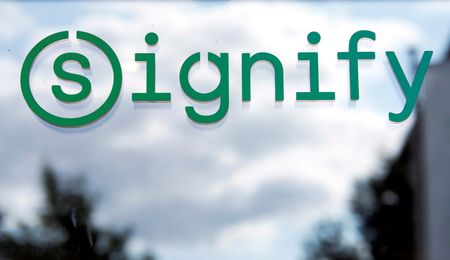By Valentine Baldassari
(Reuters) -Signify, the world’s biggest lighting maker, cut its full-year outlook on Friday, hit by lower consumer demand and a slowdown in China even as shops and businesses in Europe rush to buy more efficient bulbs to cut energy costs.
The former lighting arm of Philips said it is seeing increased demand for less energy-intensive lighting systems as energy costs soar, with governments and companies deploying efficient bulbs and technology to cut usage and bills.
Clients for example want systems to monitor and switch off lights in more than one shop, Signify Chief Executive Eric Rondolat said on a call with analysts.
“Customers are today in a bit of a hurry because they want us to implement as quickly as possible in order to get the savings also as quickly as possible,” Rondolat added.
“We also see that trend in the office space and in industry applications where everybody has an objective to try and reduce energy costs.”
Signify sells mostly LED lights and lighting systems to both consumers and businesses. It now expects adjusted earnings before interest, taxes and amortisation (EBITA) margins and free cash flow to be at the lower end of its previous guidance.
Comparable sales growth will be between 2% and 3% for 2022, down from previous guidance of 3% to 6%, it said.
Its range for adjusted EBITA margin is between 11.0% and 11.4%, with free cash flow equal to 5% to 7% of sales.
Shares were down 3.9% at 0945 GMT.
In the third quarter, the professional segment offset weaker demand from consumers, Signify said, with total sales rising to 1.91 billion euros ($1.9 billion), up 4.3% on a comparable basis.
Third-quarter adjusted EBITA reached 199 million euros, above analysts’ average expectation of 193 million in a company-provided poll.
($1 = 1.0062 euros)
(Reporting by Valentine Baldassari; Editing by Rashmi Aich and David Holmes)

